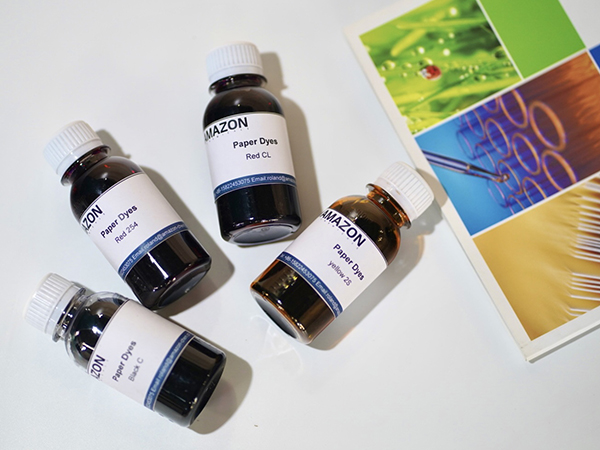Part 1: Dyeing method:
There are four main dyeing methods for paper,in-pulp dyeing, sizing press dyeing, calender dyeing and coating coloring. In-pulp dyeing and sizing press dyeing are more commonly used.
1) In-pulp dyeing paper
This is mostly dyed in pulp, that is, the dissolved or diluted dye is added to the head box, pulping tank or other appropriate positions.
For solid dyes, the dissolution and dilution of the dye is very important. Generally, first use a small amount of water to make the dye into a paste, dilute with hot water under full stirring or use indirect heating to accelerate the dissolution of the dye, and use it after filtering.
Do not heat the dye directly with steam, which will cause local high temperature, which will cause the dye to decompose, generate insoluble lakes, and produce stains on the paper.
Generally speaking, similar dyes can be mixed and used, and acid dyes and direct dyes have similar chemical structures, so they can be mixed.
In actual production, when acid dyes or direct dyes are used, a small amount of basic dyes are often added to enhance the hue.
The method of dyeing in the pulp is simple, easy to operate, and even dyeing, but the disadvantage is that some of the dye in the mesh part is lost with the white water, resulting in unstable chromaticity and poor dyeing on both sides.
2) Sizing press dyeing
This is to use coating method to dye one or both sides of the paper at the sizing press of the paper machine. The dyeing solution can be mixed with the surface sizing agent. The advantage is that the dyeing agent is less lost and the dyeing agent is changed. The type can easily change the color of the paper, but the uniformity of dyeing is poor.
Part 2: Factors affecting dyeing There are many factors affecting dyeing.
Different dyes have different properties and methods of use. Each component in the dye affects the color tone, and the fiber properties of the slurry, fillers and sizing materials have an impact on the dyeing effect, so care should be taken to select the appropriate conditions during dyeing.
1) Pulp properties:
Different pulps have different affinities for dyes, which are related to fiber properties and lignin content. Basic dyes have a great affinity for lignin, so they are suitable for dyeing pulp with high、lignin content; direct dyes have a great affinity for cellulose, so they are mainly suitable for pulp with low lignin content; straw pulp is generally better than wood Pulp is easy to stain.
Therefore, it is easy to produce stains or streaks when dyeing mixed slurry or mixing raw slurry with uneven cooking. Different dyeing conditions should be adopted according to different slurry composition;
2) Beating degree:
Fine fibers have more adsorption of dyes than long fibers, so a high-beating degree slurry is conducive to dyeing, which is related to the larger surface area of fine fibers;
Sizing material and alumina: Rosin gum has an impediment to the dyeing of sizing material, while alumina has a mordant effect on dyes, but it has different effects on different dyes.
For acid dyes, because of their lack of affinity for cellulose fibers, alumina needs to be added to promote the dyeing of pulp, and because acid dyes are negatively charged, they can only be adsorbed on negatively charged fibers by changing their charge with alumina.
For direct dyes and basic dyes, a small amount of alumina can also promote the coloring, and too much use will darken the hue and weaken the ability to resist sunlight; Filler: Many fillers have affinity for dyes and so on.When dyeing pulp containing fillers, because part of the dyes can be absorbed by the fillers, the resulting paper will have a slightly lighter color and uneven color;
3) Temperature:
Temperature has a great influence on the dyeing effect. Generally, increasing the temperature can improve the dyeing effect, especially for direct dyes.
However, the heating of the dryer part of the paper machine often causes discoloration. For example, after some acid dyes are heated, they tend to produce blocky stains on the paper surface, and some direct dyes have a tendency to fade at high temperatures.For this reason, when producing colored paper, attention should be paid to controlling the temperature of the dryer.
4) pH value:
various dyes have their most suitable pH value range, therefore, the pH value should be strictly controlled during dyeing, which is an important factor for obtaining the best dyeing effect;
5) Other chemicals:
If there are oxidizing or reducing compounds remaining in the pulp, it is not conducive to the dyeing of the paper. Therefore, there should be no residual chlorine in the bleached pulp. Calcium salt has an adverse effect on most dyes.
Dyes are generally charged. The charge interaction between dyes and other chemicals will affect the retention and dyeing effect of dyes on fibers. Therefore, when the pulp is dyed, attention should be paid to the effect of the charge of the dye and other drugs and the order of addition.
6) Double-sidedness of dyeing
Any operation that can lead to double-sidedness of sizing and filling can cause、two-sidedness of dyeing. Excessive drying cylinder temperature or uneven heating on both sides of the paper will also cause some dyes to fade or transfer dyes from the veneer side to the other side, resulting in double-sided dyeing.
In addition, the nature of the dye itself can also cause two-sided problems, mainly due to the different affinity of the dye to fibers, fine fibers and fillers.
Hope it is useful to you.
And welcome to share your views with us

